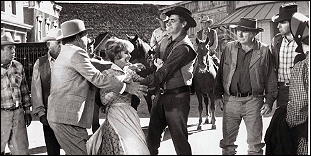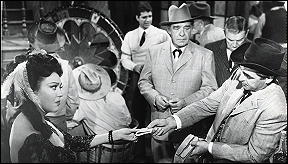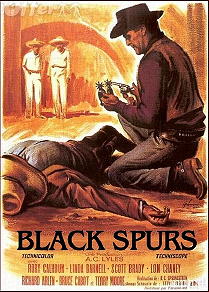Sun 15 Oct 2017
Archived Western Movie Review: BLACK SPURS (1965).
Posted by Steve under Reviews , Western movies[8] Comments

BLACK SPURS. Paramount Pictures, 1965. Rory Calhoun, Linda Darnell, Terry Moore, Scott Brady, Lon Chaney [Jr.], Richard Arlen, Bruce Cabot, Patricia Owens, James Best, Jerome Courtland, DeForest Kelley. Screenplay: Steve Fisher. Director: R. G. Springsteen.
Let me explain the title first. Anxious to earn some money so he can get married, a ranch foreman (Rory Calhoun) goes after a bank robber named El Pescadore, and along with the $3000 reward money, he also earns the right to wear the outlaw’s trademark spurs. He also loses the girl he was going to marry in the process, and soon, as he captures bad guy after bad guy, he crosses the line and (ta-boom), he’s a Bounty Hunter.

Which apparently is one rank lower than a scumlord, though it’s not clear from the move exactly why. We soon see that he’s crossed another line, however, as we find him promising to turn the small settlement of Lark, Kansas, into a helltown, forcing the railroad to move its forthcoming spur somewhere more profitable for the man he’s working for.
Guess who’s married to the sheriff of Lark, Kansas? (If you don’t know, go back and read the first paragraph again.) Guess who gets religion fifteen minutes before the end of the movie? (Aw, you’ve seen it before.)

Steve Fisher, who wrote the screenplay, was one of the better pulp writers of the 1930s before going to Hollywood, so the story is actually pretty good. It is certainly a step above the average Gene Autry picture, say, but it’s no classic either. The cast of veteran actors seem to know what they are doing at all times, but it’s a downright shame that Linda Darnell had to end her career as the madame of a traveling group of bordello girls — this was the last film she made before she died.


